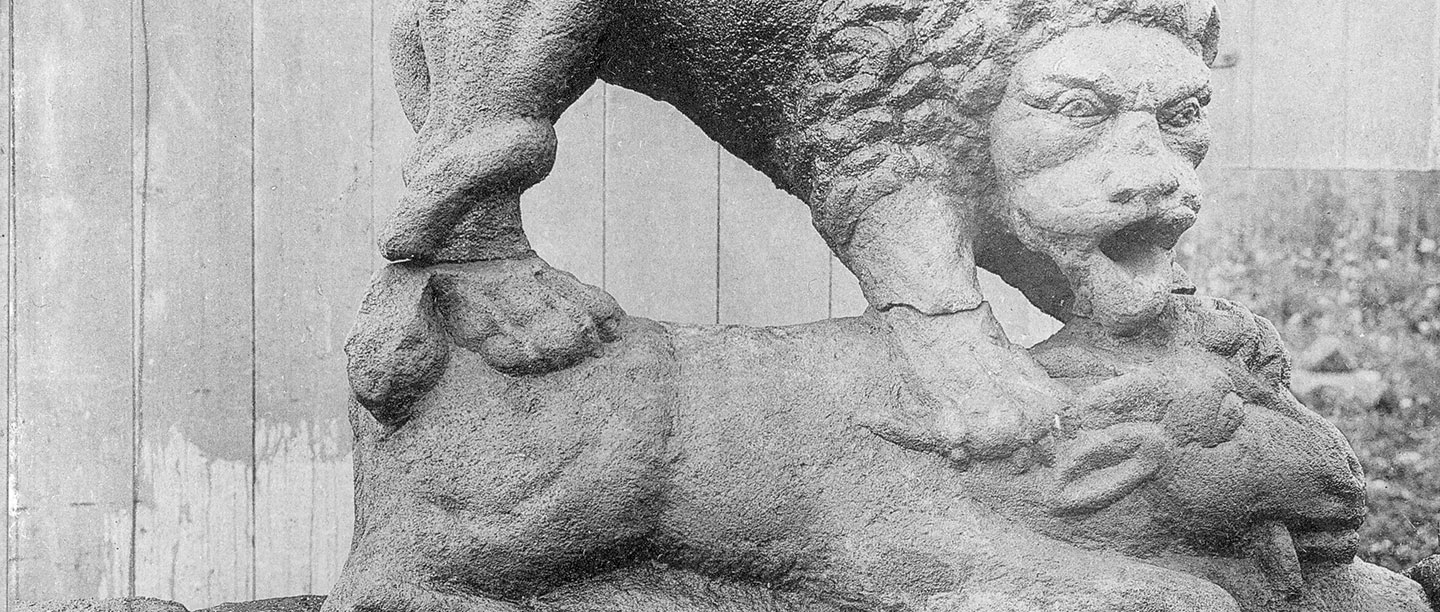Show Piece
This sculpted lion is one of the most famous pieces in the Corbridge collection. The best preserved of five lion statues from Corbridge, the detailed carving depicts a male lion ferociously pouncing on its prey. The identity of the prey has confused sculptural experts, so English Heritage asked a zoo-archaeologist, used to identifying animals, to give us an assessment. The horns and ears would suggest the sculptor was depicting a sheep or goat, but the size in comparison to the lion is that of a cow. It’s possible that the sculptor wanted the lion to seem even more impressive for killing a larger animal. The contrast between the strength of the lion and the limpness of its victim is portrayed beautifully. This is clearly the work of a skilled craftsman.
Lions were a common decoration for funerary monuments in Roman Britain, and it’s likely that the Corbridge lion was originally made to go on top of a mausoleum. However, it was found within the grounds of a large private property. With 23 rooms, the house the lion belonged to was by far the largest residence in Corbridge. This house, in the area of the site to the south-west of the public area, was on the edge of the promontory which overlooks the River Tyne. It had a hypocaust (under-floor heating) for heating the house, its own latrines, and painted wall plaster in various rooms. The property was the home of a wealthy resident of Corbridge and was occupied right up to the end of the 4th century.
It appears the ever-resourceful Romans recycled the mausoleum sculpture. They removed the lion’s teeth and used his mouth as a spout for a large fountain. The absence of water erosion below the mouth suggests that he had a pipe in his mouth to direct the water clear of the stone. The cistern was built in the early 3rd century and went out of use by the beginning of the next century.
Lion symbolism
However we know that the residents of Corbridge did once use lion sculptures in a more sacred context. A much more worn lion was found in situ, lying where it had fallen from the wall of an enormous mausoleum known as Shorden Brae, 600m west of Corbridge. The lion was part of a pair set on the mausoleum’s outer wall, and predates the Corbridge lion by about half a century.
Built in the form of a tower, the tomb has no parallel in Roman Britain and is one of the largest tower tombs known from the Roman world. Excavated in 1958, the tomb measured an enormous 10m2 and the thick precinct wall surrounding it would have covered an area of 40m2. Whoever was buried in this monument came from a family of wealth to be able to afford this, most likely a high ranking officer such as a legionary commander.
The Romans buried their dead outside of settlements, often along roads. This ensured that all travellers to and from the town would see the graves, and so remember the dead. As Corbridge Roman Town was situated at the junction of two major roads – Dere Street and the Stanegate – the Shorden Brae mausoleum would have been a prominent landmark at the north-western border of the Roman Empire.
The decision to decorate the tomb with the lion statues shows how important the lion symbolism was in Roman burial rites at this time. Another famous Roman lion was discovered buried in mud in the banks of the River Almond in Cramond, near Edinburgh. Dating from the mid 2nd to the early 3rd century, the lioness in this sculpture is shown devouring a naked bearded man. Like the Shorden Brae lion, it was probably a memorial to an important Roman officer, and reflects the importance of death rites in Roman Britain at this time.
Changing Beliefs
The example of the Shorden Brae lion makes the discovery of the Corbridge lion even more remarkable. How and why did such an important mausoleum statue come to be used as a fountain in a private residence? Violation of a tomb was a criminal offence in the Roman period, and tombs elsewhere in the Empire have inscriptions or curses warning of the consequences of such violation.
However experts believe the Corbridge lion was never actually used in a mausoleum. Due to the lack of wear, it seems likely that it was taken directly from a mason’s stock in order to adapt it into the fountain head. To our modern view, it’s an interesting choice for a fountain. Did the owners of the large house view the symbolism differently? Or was the symbolism seen as appropriate within a residential setting, not just a funerary one?
While the lion is not evidence of desecrating a funerary monument, there are other pieces from the site which are. Corbridge was occupied for around 350 years, and recycling of stone happened throughout the period, including with religious, funerary and building stones. For example in the 4th century – sometime after the Corbridge lion was turned into a fountain – tombstones were used to re-surface the Stanegate road running through the settlement. While it might seem wrong to us to reuse funerary monuments like this, the 4th century population did not seem to have the same qualms.
Roman beliefs were incredibly varied and diverse, and continued to evolve and change throughout the Roman occupation of Britain. We will probably never know the true nature of the beliefs of the wealthy residents who turned their lion into a fountain, but the sculpture survives today to remind us of the complexity and richness of Roman art, culture and religion in Corbridge Roman Town.
Explore More
-
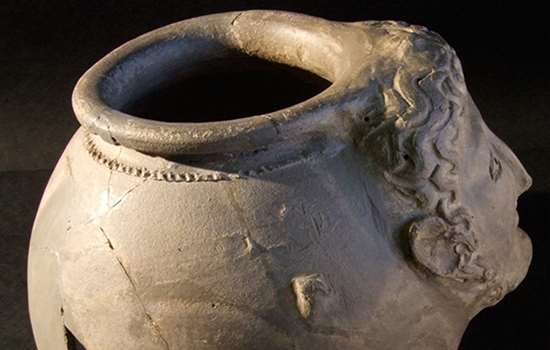
The Mysteries of Corbridge
From strange heads on pots to missing temples, there are many things about Corbridge that continue to puzzle us. Read about the site’s most enigmatic mysteries here.
-
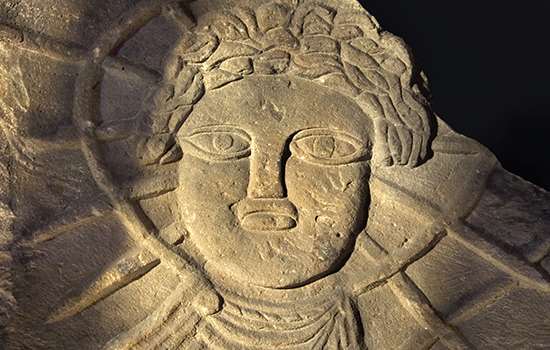
Corbridge: History and Stories
Corbridge developed from a military outpost into a cosmopolitan town. Explore its history and extraordinary collection of objects.
-
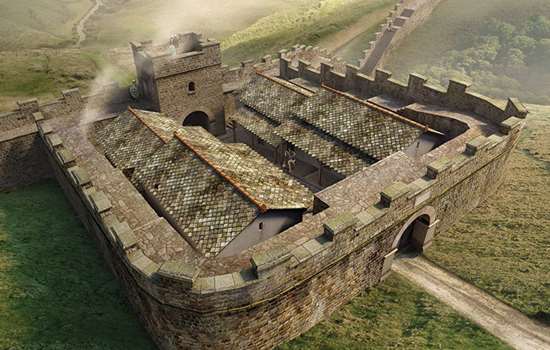
Hadrian’s Wall: History and Stories
Discover the histories, stories and mysteries associated with English Heritage’s Hadrian’s Wall sites.
-
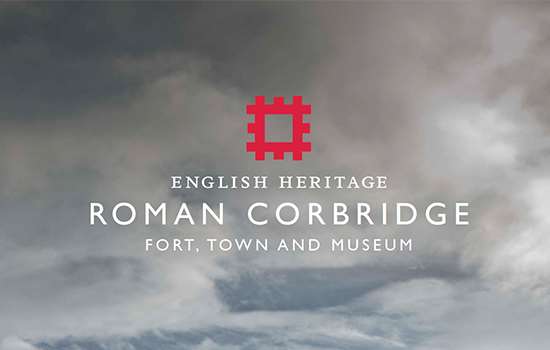
Buy the Guidebook
This guidebook gives a full tour of the site and museum as well as a detailed history of Roman Corbridge.
